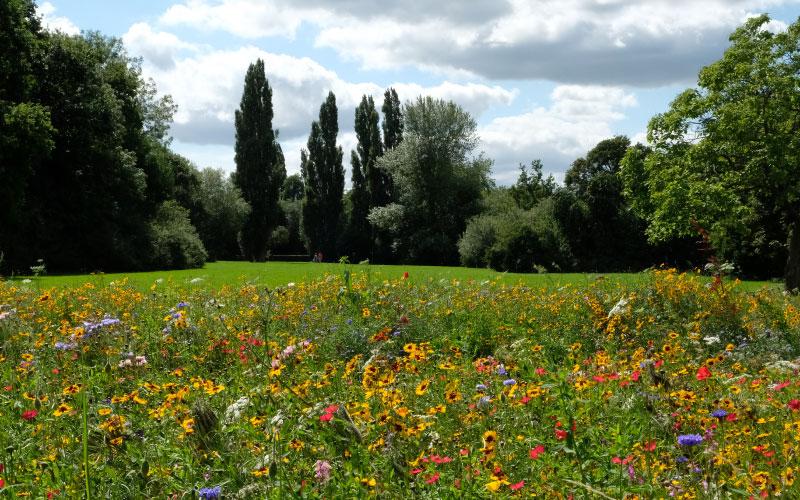
Biodiversity Net Gain becomes a legal requirement for major housing developments
On Monday 12 February 2024 Biodiversity Net Gain (BNG) became a legal requirement for all major housing developments.
Under BNG, major developments in England must replace any biodiversity lost and add a minimum of 10% biodiversity to provide a net gain. The resulting habitat will be secured for at least 30 years via planning obligations or conservation covenants.
A tool called the biodiversity metric will calculate the ecological cost of development on an area of land and generate a number which the developer must compensate for. This compensation currency is called a ‘unit’.
The number of units generated by the biodiversity metric for any given development depends on various factors including:
- Distinctiveness: the type of habitat and its features, including species richness, rarity, whether the habitat is protected and the degree to which a habitat supports species rarely found in other habitats
- Condition: variation amongst the same habitat type
Once assessed using the biodiversity metric tool, a biodiversity gain plan will outline how developments will deliver biodiversity net gain and allow the planning authority to check whether the proposals meet the biodiversity gain objective.
The full biodiversity gain plan will be submitted either with the planning application or after the permission is granted, but before development has commenced.
What habitats will be created?
Local planning authorities have the option of setting priorities (for example, woodland creation or enhancing ecological networks) for biodiversity within their administrative area, which may be identified in collaboration with local wildlife organisations and stakeholders. These priorities will be formalised in local plans and planning decisions.
Therefore, in most cases developers will be given guidance on what form their biodiversity contribution should take. Pre-development assessments will also identify higher value or even irreplaceable habitats already on-site, which will be protected under best practice.
Where will habitat creation take place?
Best practice guidance dictates net gains should be delivered locally to the development site. In addition, a ‘spatial risk multiplier’ attached to the biodiversity metric tool will incentivise developers to undertake biodiversity improvements within the boundary of a development (on-site), by reducing the biodiversity value of habitats delivered further away from the development.
Where on-site improvements are not possible (for example where there is not space on site for the development and habitat areas) improvements can be made off-site. The term ‘off-site’ in the context of BNG may mean on land owned by the developer, which is away from the development site, or alternatively by purchasing units sold by third-party land managers who are already in the process of creating new habitats throughout the UK.
Estimates using 2019 housing delivery data suggest on-site and off-site habitat creation will demand a total of 5,400 ha of land each year in England.
Trading BNG units
The development of a third-party BNG unit marketplace was an intended consequence of the BNG scheme, and numerous businesses already offer units for sale throughout the country (type ‘BNG units for sale’ into Google for examples).
Off-site units being sold by third parties generally form part of large, privately managed habitat restoration projects, ranging from grasslands to re-wilding and re-wetting projects. Thousands of units are already available for purchase, which is just as well, since Defra estimate 1,300 ha of off-site units will be sought each year by developers.
The cost of each unit being sold by third-party providers will include management of the land for at least 30 years, monitoring and reporting, ecologist or other experts’ costs, insurance, costs to cover work if the habitat fails, machinery, tools and other staff to carry out the tasks, inflation and market competition costs and the cost of legal administration. Defra estimate the cost for each unit is likely to be in the region of £9,000 - £15,000, however, due to the immature nature of the market, this figure may vary. Crucially for developers, once they purchase BNG units from third parties, they absolve themselves of all liability for BNG mitigation.
Developers who cannot use on-site or off-site units to deliver BNG must purchase ‘statutory credits’ (note the difference in terminology between units and credits) from the government. This option is regarded as a last resort and priced accordingly high; statutory credit prices are set to ensure they do not compete with the development of units for sale by third parties. The proceeds from the sale of ‘statutory credits’ will go towards government-led conservation projects.
When does BNG apply to smaller development projects?
BNG will apply to new applications for smaller development projects from 2 April 2024.
Small sites are defined for the purpose of the BNG exemption as:
(i) For residential: where the number of dwellings to be provided is between one and nine inclusive on a site having an area of less than one hectare, or where the number of dwellings to be provided is not known, a site area of less than 0.5 hectares.
(ii) For non-residential: where the floor space to be created is less than 1,000 square metres OR where the site area is less than one hectare.
Note: Roll-out of BNG for Nationally Significant Infrastructure Projects is expected in late 2025.
Further reading
Defra press release: New housing developments to deliver nature boost in landmark move

